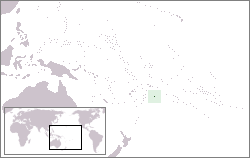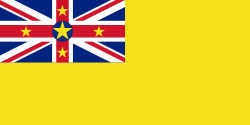Difference between revisions of "Niue" - New World Encyclopedia
Mike Butler (talk | contribs) (Niue - importing) |
Mike Butler (talk | contribs) m |
||
| Line 141: | Line 141: | ||
[[Category:Oceanic dependencies]] | [[Category:Oceanic dependencies]] | ||
[[Category:Polynesia]] | [[Category:Polynesia]] | ||
| + | {{credit|42893118}} | ||
Revision as of 07:49, 12 June 2006
| |||

| |||
| Official languages | Niuean, English | ||
| Capital | Alofi | ||
| Head of State | Elizabeth II | ||
| New Zealand High Commissioner |
Anton Ojala | ||
| Premier | Young Vivian | ||
| Area – Total – % water |
260 km² 0 | ||
| Population – Total (July 2005) |
1,445 | ||
| Establishment – Date |
Niue Constitution Act 19 October 1974 | ||
| Currency | New Zealand dollar | ||
| GDP | $ 7.6 Million ( 229) | ||
| Time zone | UTC -11 | ||
| National anthem | Ko e Iki he Lagi | ||
| Calling Code | 683 | ||
| Internet TLD | .nu | ||
| 296px | |||
| Map of Niue | |||
Niue is an island nation located in the South Pacific Ocean. It is commonly known as "Rock of Polynesia". Although it is self-governing, it is in free association with New Zealand. This means that the sovereign in right of New Zealand is also the head of state of Niue, and most diplomatic relations are conducted by New Zealand on Niue's behalf. Niue is located 2,400 kilometers north-east of New Zealand in a triangle between Tonga, Samoa and the Cook Islands.
History
European involvement in Niue began in 1774 with Captain James Cook's sighting (landing was refused) of what he named "Savage Island". Legend has it that Cook so named the island because the natives that "greeted" him were painted in what appeared to Cook and his crew to be blood.
The next major arrival was the London Missionary Society in 1846. Niue was briefly a protectorate, the UK's involvement being passed on in 1901 when New Zealand annexed the island. Independence in the form of self-government was granted by the New Zealand parliament in the 1974 constitution.
In January of 2004, Niue was hit by the fierce tropical storm Cyclone Heta which killed two people and caused extensive damage to the entire island.
Politics
The Niue Constitution Act 1974 (NZ) vests executive authority in Her Majesty the Queen in Right of New Zealand and the Governor-General of New Zealand. The constitution specifies that in everyday practice, it is exercised by a Cabinet of the Premier of Niue and three other ministers. The premier and ministers must be members of the Niue Assembly, the nation's legislative assembly.
The assembly consists of twenty democratically elected members, fourteen by the electors of village constituencies. The remaining six are elected the same way, except several constituencies are combined for each seat. Electors must be New Zealand citizens, resident for at least three months, and candidates must have been electors, resident for twelve months. The speaker is elected from among the members.
Geography
Niue is a 260 sq km island located in the southern Pacific Ocean, east of Tonga. The geographic cordinates of Niue are 19°02′S 169°52′W.
There are three geographically outlying coral reefs within the territorial waters, that do not have any land area:
- Beveridge Reef, at 20°00'S, 167°48'W, 300 km Southeast, submerged atoll drying during low tide, 9.5 km North-South, 7.5 km East-West, total area 56 km2, no land area, lagoon 11 meters deep
- Antiope Reef, at 18°15'S, 168°24'W, 193 km Southeast, is a circular plateau approximately 400 meters in diameter, with a least depth of 9.5 meters
- Haran Reef (Harans Reef), at 21°33'S, 168°55'W, reported to break furiously
- Albert Meyer Reef, at 20°53'S, 172°19'W, almost 5 km long and wide, least depth 3 meters, not officially claimed by Niue, existence doubtful
- Haymet Rocks, at 26°S, 160°W, existence doubtful
Niue is one of the world's largest coral islands. The terrain of Niue consists of steep limestone cliffs along the coast with a central plateau rising to about 60 metres above sea level. A coral reef surrounds the island, with the only major break in the reef being in the central western coast, close to the capital, Alofi. A notable feature of the island is the number of limestone caves found close to the coast.
The island is roughly oval in shape (a diameter of about 18 kilometers), with two large bays indenting the western coast (Alofi Bay in the centre, and Avatele Bay in the south). Between these is the promontory of Halagigie Point. A small peninsula, Tepa Point (or Blowhole Point) is located close to the settlement of Avatele in the southwest. Most of the island's population reside close to the west coast, around the capital and in the northwest.
The island has a tropical climate, with most rainfall occurring between November and April.
Defence and foreign affairs
Niue has been self-governing in free association with New Zealand since 1974; Niue is fully responsible for internal affairs; New Zealand retains responsibility for foreign affairs and defence; however, these responsibilities confer no rights of control and are only exercised at the request of the Government of Niue. Niue has no regular indigenous military forces.
Economy of Niue
Niue's economy is very small with a GDP of around $7.6 million estimated in 2000. Most economic activity centres around government and work on family plantations. It uses the New Zealand Dollar and relies on New Zealand aid to sustain its government.
However, in August 2005 an Australian mining company Yamarna Goldfields has suggested that Niue might have the world's largest deposit of uranium. It has permission to drill on the island to confirm geological data that suggests the presence of a very large deposit. It will require government permission, however, to convert its prospecting licence to a mining lease.
Foreign aid, principally from New Zealand, has been the island's principal source of income. Tourism generates some revenue but there is very little industry on the island. Remittances from Niuean expatriates generally from New Zealand constitute a significant proportion of Niue's income as well.
Government expenses usually exceed revenue to a substantial degree, with aid from New Zealand subsidising public service payrolls. The government generates some limited income also from the sale of its postage stamps to foreign collectors and domain names, with its top level domain .nu. The Government briefly flirted with the creation of "offshore banking" but under pressure from New Zealand agreed to end its support for schemes designed to minimise tax in countries like New Zealand.
Niue's economy suffered from the devastating tropical cyclone of 2002.
See also
- Music of Niue
- Communications in Niue
- Demographics of Niue
- Transportation in Niue
External links
- The Official Website of the People of Niue
- Electionworld file on Niue
- History of Niue
- Internet Users Society Niue site
- Map of Niue
- Niuean Government site
- Niue National Telecommunications Policy 2003
- .nu domain name registry site
- Register article which mentions the impact of the cyclone
- World Factbook entry on Niue
- Environment Department
- InvestNiue
- Niue Business News
- Statistics Niue
- Niue Tourism
Template:New Zealand Template:Polynesia Template:Pacific Islands
Credits
New World Encyclopedia writers and editors rewrote and completed the Wikipedia article in accordance with New World Encyclopedia standards. This article abides by terms of the Creative Commons CC-by-sa 3.0 License (CC-by-sa), which may be used and disseminated with proper attribution. Credit is due under the terms of this license that can reference both the New World Encyclopedia contributors and the selfless volunteer contributors of the Wikimedia Foundation. To cite this article click here for a list of acceptable citing formats.The history of earlier contributions by wikipedians is accessible to researchers here:
The history of this article since it was imported to New World Encyclopedia:
Note: Some restrictions may apply to use of individual images which are separately licensed.
